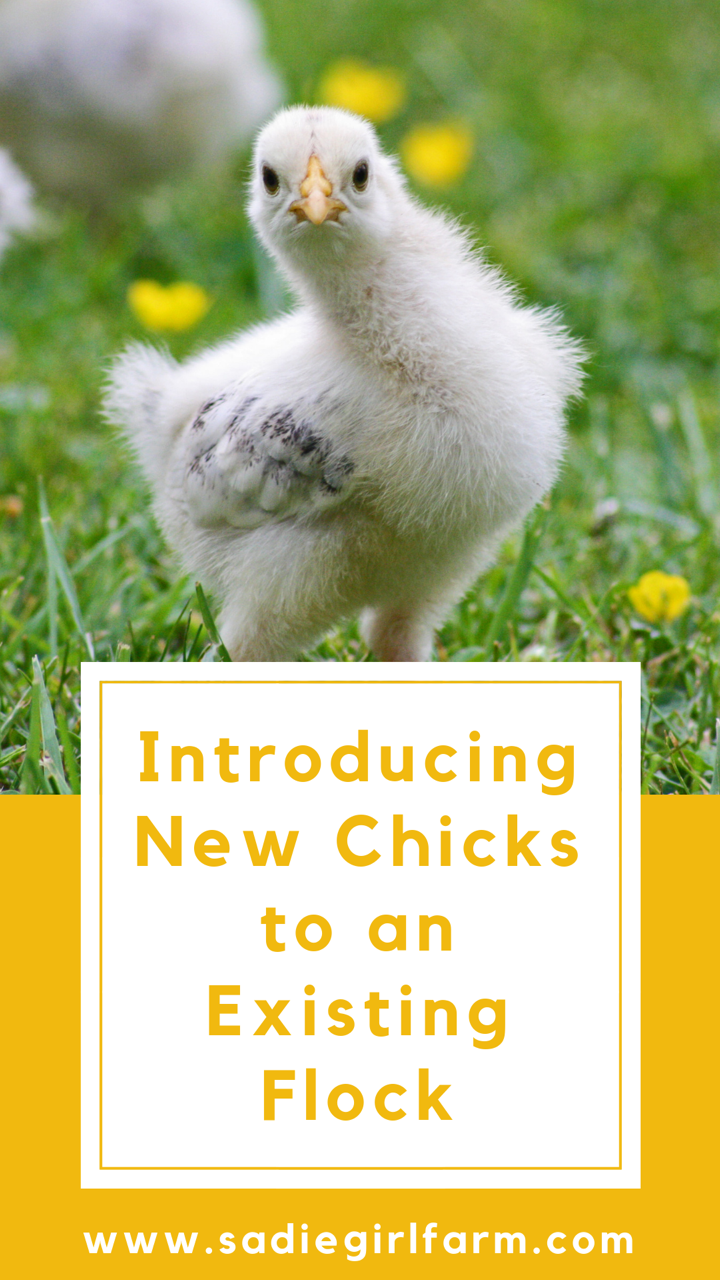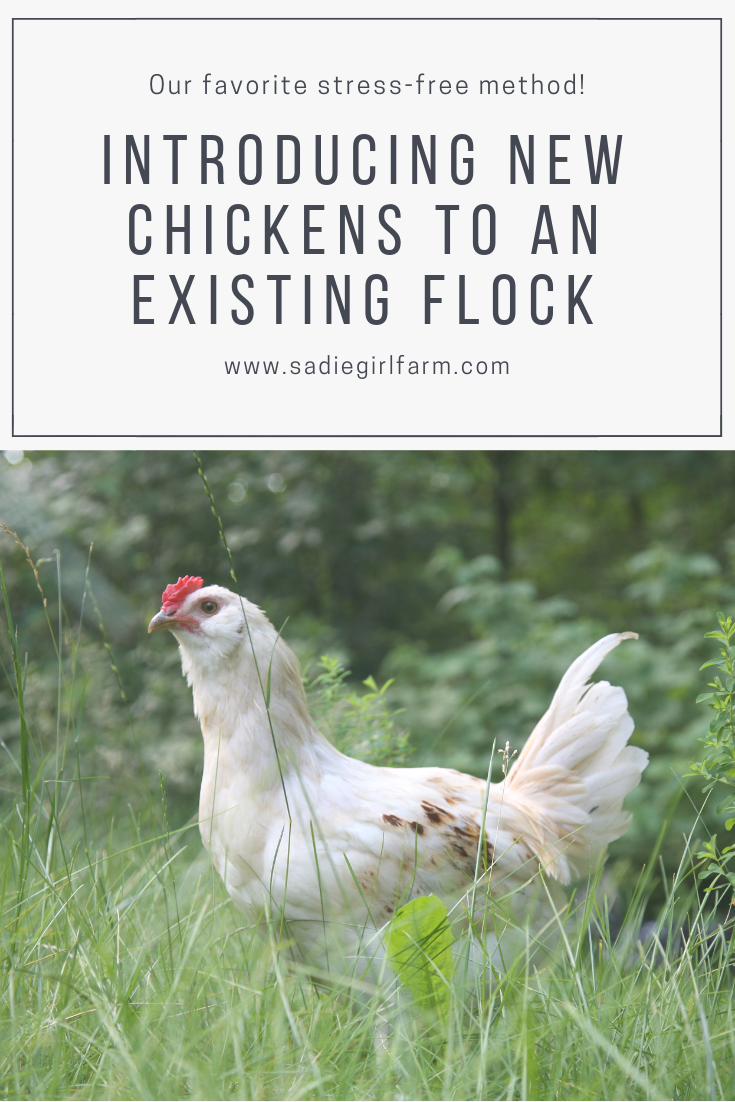Introducing New Chickens To An Existing Flock
A really common question I get from my customers is how do you introduce new chicks to your existing flock of chickens? This is such an important question, and you will get TONS of answers depending on who you ask!
Well over the years, we have introduced a lot of young chickens, as well as older hens, to our various flocks. We have tried (almost) every technique in the book and have found a method that we prefer and now use every time.
Here is our no-stress method! (or at least less-stress, if you are a natural worry wort like I am!) First of all, if you have baby chicks, make sure you are housing them indoors with a heat source, for the first 4-6 weeks (depending on the outside temps). If you need more info on how to care for chicks during those first several weeks, you can check out the blog post I did on that, here.

So once your chicklets are old enough to be outside, you can move them out, to start getting used to the adult chickens. We do this gradually… the entire process takes about 2 weeks or so.
Phase 1… set up a pen or cage inside or next to, your existing flock. For us, our coop is large enough that we just portion off a corner of it with wire fencing and a piece of wood over the top. We have also put a large dog crate in the corner of the coop, and this works great for a couple of chicks. If your coop and run are too small to do this, you can fashion a setup for the chicks, alongside your existing chickens. What we want to do, is house the new chicks near the older chickens, so that everyone can start getting used to seeing and being around each other. This is not long-term, only for about a week or two.
Phase 2… (If your chicks are very young, I like to wait until they are about 7-8 weeks old before beginning phase 2)
If you currently let your chickens out to free-range for any amount of time, that is ideal! After a couple weeks getting to know each other through the fence, we like to let everyone out to free range and we spread out lots of tasty snacks (kitchen scraps are our go-to snack!) and let the adults and teenagers free range together for a bit. This is great to do in the afternoon or evening, when you can be home with them to SUPERVISE. Make sure your snacks are spread way way out so there is no quarreling over who gets what. This is a great low-stress environment to mix and mingle for the first time, where the little ones have plenty of room to run away if needed, and the adult chickens are distracted by being let out and looking for tasty morsels. Make sure to supervise the entire time, because while some pecking and chasing are normal (everyone must establish the new pecking order), you would want to intervene if a young chicken was being seriously hurt by one of the older ones. Do this a few times over the next few days. Weekends are the best for Phase 2 at our house!
Phase 3… Once everyone has been let out together several times, and it seems like it is going fairly peacefully, you can start phase 3. At night (this is very important) once the adult chickens have roosted and “gone to sleep”, quietly move the teenagers into the adult coop. Make sure (ahead of time) that you have enough roosting bars for ALL the chickens, new and old. 1 foot of roosting bar per chicken is a great rule of thumb. Place the new teens onto a roosting bar above or at the same level as the adult chickens (if your roosting bars are at different heights). This is important, because where a chicken roosts, has to do with the hierarchy… if the chicks are below the adults, the adult chickens will know that they can harass them, since they are lower on the totem pole, so to speak. If they are higher, the teens will get more respect. We do this at night, because chickens go into a little trance at night and don’t protest being moved around. This is so much less stressful on the chickens (and you!) then trying to do it while they are awake. Also, when chickens wake up together, they are like “oh, you must have been here all along!” and so it really eases that transition.
Keep an eye on things for a few days afterwards. Remember, some pecking and chasing is normal as they decide who is where in the pecking order. A great idea is to put something in the coop and/or run so that the little ones can hide if they feel they need to. These can be branches in a corner or a board leaned against a wall so they can duck behind it. This seems to help them with their stress level as they adjust.
The most important things for helping chickens get along, is to make sure everyone has enough food, fresh water, and SPACE. I would fight with my family too if we were all locked in a tiny room together for hours on end! A great idea is to have a few different food and water containers in the beginning, so there is no one keeping the babies from getting food or water; lots of options to share!
If there is some harassment going on and the chicks are super stressed or getting injured, the best thing to do is to remove the chicken that is doing the harassing. (usually it is just 1 chicken, sometimes 2, who are the bullies). You can put them in their own cage/crate away from the other chickens for a day or 2. This will knock them all the way down the pecking order, so when they go back into the group, they will start at the bottom, NOT as head honcho! We have had to do this with a few bossy hens, but it is rare.
This whole process would be the same if you were introducing a full grown hen into the mix. However, we have found it is MUCH better to introduce more than 1 newcomer at a time, so that the established flock doesn’t gang up on the 1 new gal. This process is SUPER easy if you are introducing a new full grown hen to some younger ones! We have had customers report being able to just stick the new gal in with their young flock, and everyone adjusts just fine!
So it does take a little bit of time and effort, but introducing new chicks to your older hens does not have to be super stressful like some folks think it is. Just follow the steps, and you will have one big happy chicken family in no time!

